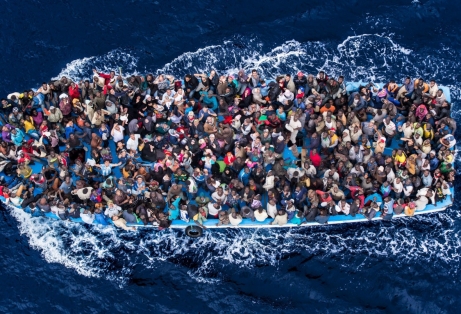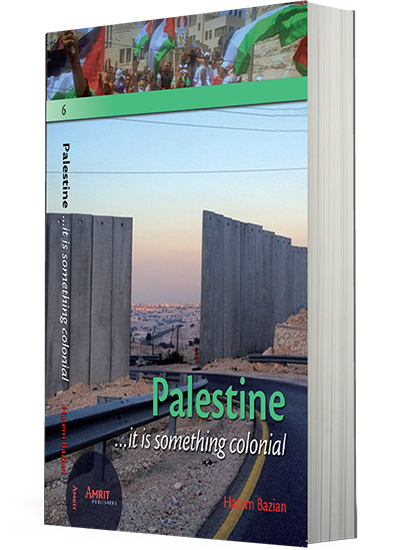Existing fault lines in post-colonial states have a long history behind them and are present across the world. Some may assert that we cannot accuse the global North of initiating or creating them in the first place. However, the colonial global North has achieved mastery at the divide-and-conquer game and nothing was deemed sacred within the colonially framed set of ends-justify-the-means approach, including the human being and his/her relation to God. Let us be clear that the link between colonial discourses and racism is ontological with each one being the progeny of the other as a two-headed monster sharing disfigured heart and body.
Today’s world is framed and organized around the colonial epistemic and nothing escapes its hegemonic reach. The term globalization, the current invasive and exploitative type, is nothing more than the continuation of the colonial regime under a more improved control and command structure with the highest value being cost savings and efficiencies.
How is the immigration crisis today linked to colonialism and post-colonialism in the first place? Indeed, this is an important question I will turn to next in detail while keeping the earlier section in mind. Earlier we discussed how the colonial and post-colonial project was vested in capturing and maintaining access to raw materials, dominating markets and controlling trade with the use of violence coupled with internal and external control structures. In order to develop a concrete argument on the link between collapse of the post-colonial state and immigration I will have to go back and trace the key factors that shaped the colonial project itself with particular emphasis on the forceful movement of indigenous populations across the globe.
Certainly, the modern colonial project included the forceful and involuntary movements of millions of people across borders and continents. This fact is illustrated by going back to 1492 as an important demarcation in the ushering of the modern colonial project. Central to its success was the expulsion and removal of Jews and Muslims for white supremacist Europe to emerge into being. Prior to this period, the idea of Europe as a continent that is separate, white and Christian had no meaning or reality. Thus, Europe had to be ideologically invented and brought to life through the otherizing and removal of Jews and Muslims from the continent. Purity of race and blood was constructed and refined in relations to and opposite of the other: The Muslim and Jew (who were mostly of North African and Sub-Saharan African background).
The expulsion did not end in 1492, rather, it continued with the inquisition issuing of various Black Codes and culminated almost a 100 years afterward with forcefully removing from Spain those who initially were converted to Christianity but continued to practice Judaism or Islam in secret. On April 9th, 1609, King Philip III of Spain issued decree that called for the total removal of the Moriscos, the descendants of Muslims who a century earlier were forcefully converted to Christianity as a condition to remain in the Iberian Peninsula. Aside from focusing on the religious identity of those expelled, the bigger picture had to do with Europe’s constructing its identity through this process and then setting in motion the very pernicious and racially hierarchical modern world. In this context, modernity was constructed on the basis of race, expulsion and exploitation whereby existing religious differences were racialized to become the basis of separation and exclusion.
Modern European colonialism’s first targets were internal subjects, the Jews and Muslims alike. Europe’s ideological and epistemic walls were constructed around Muslim and Jewish supposed threat or defilement of the Christianly demarcated geographic space, which must be purified and cleansed so as to serve its ‘sacred’ purpose. At the same time, and just a few months after the forceful expulsion of Muslims and Jews in Spain, the most destructive and successful genocidal settler colonial project was unleashed on the indigenous populations of the Americas. Often the treatment of these two monumental events as separate and belonging to different episteme is shortsighted, since the basis of otherization, sub-humanness and racial difference was articulated in Europe before Columbus’ journey across the Atlantic. This was a continuation (more violent and genocidal) rather than a break from the recent past.
The multiple genocides in the Americas were made possible by a series of European ideological shifts, technological developments and persecutions that calumniated first, in the expulsion, then followed with attempts to search for an alternative route to India and away from Muslim held territories that ended with Columbus crossing the Atlantic. More critically, the alterative route was an attempt to disrupt and bypass existing trade patterns that had been in existence for centuries with Europeans’ focus on dominating and controlling the market for themselves. Furthermore, the competition between Northern, Southern and Eastern European powers was likewise, focused on trade and domination of markets. Those Southern and Eastern European powers who were part of the existing trade system in the Mediterranean lost out to the Northern and Western powers with far reaching impacts lasting centuries.
One may legitimately ask, what does all of this have to do with immigration and the massive influx from the global South at present? This is an important question and still needs further history before arriving at the present circumstances and the human flood coming from the global South.
Genocides against the indigenous populations in the Americas necessitated the importation of a ‘labor force’ to work the massive lands taken by European settlers, systematically and industrially depopulated by disease, death and destruction. ‘Labor force’ it was but not by choice, rather it was the massive importation of slaves from Africa that covered the need in the new colonies.
Slave importation to the new world was a type of involuntary immigration (this term gives little justice to what was/is done to the slaves and their descendants) that disrupts regional economies in West Africa while accelerating and intensifying conflicts at the local level to produce the needed slaves to be shipped to the colonies in the Americas. European settler colonialism in the Americas was a global project and emerged out of an interconnected set of events in Europe, Africa and the new colonies in the West. This project is connected to the expulsion of the Jews, Muslims and Moriscos from Spain, multiple genocides of indigenous populations and importation of slaves that lead to the disruption of West and Sub-Saharan African regions, altering trade routes and reconfiguring capital and industrial markets across the globe. Every part of the globe was and continues to be affected by the events that unfolded in the past 400 years or more.
Indeed, the Settler colonial moment of arrival in the Americas was ushered with forceful dislocation that has never been accounted for and is yet to be fully documented, undone or let alone stopped. Colonialism set in motion involuntary human movement from all parts of the globe, which is totally different to anything experienced in the past and once coupled with the introduction of racial classification it made for the most devastating consequences.
Settler colonialism in the new world opened the door wide for forced and involuntary human movement. The non-settler type of colonialism likewise introduced forced human movement across the global South and starting with removing indigenous populations from regions rich in natural resources and handing it to northern companies to exploit and pillage. The removed populations were then recruited to work at times on their own stolen lands or in other regions and became a steady source for cheap labor and at times were pitted against other indigenous groups in various areas to neutralize internal resistance and make it easier for the colonialist to control all resources and power. In due time, the colonized populations who were left landless, stateless and unemployed got recruited into the colonial military and bureaucracy then shipped to distant lands to enforce the colonial structure against other colonized subjects. In this, we have the beginning of the labor relationship between the colonized and the colonizer that down the line will lead to importation of this same working force into the colonial motherlands in the North.
Furthermore, the ‘native expert’ or ‘native informant’ was taken to the colonial motherland to be ‘educated’ and similarly, opened doors for voluntary structured immigration from the colonized global South to the North. Initially, the numbers were rather small but in due time increased to include most, if not all, members of the elite ruling class from the colonies, so as to be educated and sent back to manage native populations and oversee the economy for the colonizers. In this process, the voluntary movement of the colonized subjects from the global South to the North, and then back to the South, initiated a process that continues until the present day. More to the point is the critical role played by the colonial global North in shaping and constructing meaning and ideas about the colonized self through the colonial lens and not independent of it. Furthermore, the process unleashed the endemic brain drain crisis since the best and brightest are inducted into the colonial machinery of the global North and are incentivized to stay in close proximity to the colonial center. The best and brightest from the global South are relocated to the global North and while some become very critical and produce masterful pieces, nevertheless, the structural damage to the South is irreversible and, indeed, for some the success of the few is introduced as a proof for the veracity of the colonial ‘civilizational’ project itself.
Connected to this and just as important of a factor in the brain drain and immigration draw can be found in media framing and production concerning the conditions in the global North, and the desire to arrive at the pinnacle of human progress and paradise on earth. Here, the global North becomes the location where the imagined good life and possible perfection of the human condition is located, which is precisely what colonial racial conditioning desired to achieve. Also here, media becomes an avenue for transplanting this notion in the colonial subject subconscious and drives him/her to seek arrival at the shinning Northern colonial city upon a hill. Media and image production is not separate or distinct from the colonial epistemic, rather it emerges and represents it in popular culture, literature, paintings, songs and movies for all work as a canvas to blot more whiteness onto its existing colonial white supremacy.
The colonial project moved slaves to the Americas, imported and utilized colonized populations as foot soldiers around the world, trained low-level bureaucrats to administer various colonies, recruited elites for the purpose of education and administration of the global South, and finally brought massive illiterate and uneducated menial labor forces to clean houses and collect the garbage in cities and towns in the heart of the colonial motherland. What made these populations available for such forced movement and immigration, was a constitutive of the colonial project itself and shaped the post-colonial dynamic that is being experienced up to this point.
Colonization begins with land and the resources present in it. Controlling the raw materials discussed above was made possible by the forceful removal of populations from their ancestral lands. In this process, the colonizer gained access and eventually owned the land and everything on it including the people themselves. Thinking of land and its centrality to daily life: housing, agriculture, natural resources, underground water, roads and transportation, all types of pipelines, electricity generation, energy, silicon, gold, silver, minerals, precious stones, sport activities, advertisement space, and military defenses to name a few. The takeover of the land is central to the colonial project and continued to shape the post-colonial for those stolen lands were never returned. Indeed, removing colonized populations from the land created surplus labor or more like manufacturing poverty conditions that makes individuals focused solely on seeking to fulfill basic human needs of food and shelter. Possessing land for indigenous populations translates to self-sufficiency in food as well as sustainable living from what can be grown and consumed locally from the owned land (ownership be it individually or collectively).
Colonization was focused on severing the indigenous populations’ land relations and replaced it with a colonial economy focused on achieving total dependency on colonially supplied and market controlled products. Since the colonizer already took possession of the best lands and the more lucrative resources, then the ability to control the livelihood of the colonized populations is the instrument deployed to engender cooperation and malleability to colonial demands.
Forceful removal from the land had far reaching consequences and disrupted the existing tribal, social, political, economic and religious balances in colonized regions. A by-product of forceful removal and population movement away from their ancestral lands is the intensification of conflicts among the various local groups. As each group is moved or separated from its own land, they begin to struggle to keep more of the shrinking territory and resources at the expense of another group facing similar circumstances. This conflict had the further benefit for the colonial power to fragment existing societies at the micro level, thus increasing the ability to control and manipulate local politics and select those who are ready to sell their soul and community to the highest bidder. Death, murder, destruction and genocide are constitutive and productive in the colonial project with devastating results across the globe. Whenever violence is witnessed in the global South focus not on the immediate identity of the foot soldiers fighting for survival on the plantation level but look for those near and far who situated, nurtured, benefited and administered the colonially constructed plantation with murderous viciousness.
The loss of land disrupted local economies built over centuries and collapsed existing supply and demand patterns to be replaced by a major colonial company vested in driving maximum profits to investors in the global North. Furthermore, the local economy was to be kept at a low level of development producing raw materials to feed the industrialized colonial motherland’s economy that then turned around finished and more expensive products to be sold in the global North and South. The raw material economies in the colonies were structurally kept in an underdeveloped stage so as to maintain employment, manufacturing and innovation protected in the global North.
Forceful removal from land, displacement, intense local conflicts other factors discussed above created a trans-historical dependency and structural disruption in the global South. The immigration/relocation door was opened and was utilized by the colonial powers to drive the material and political benefits from the global South, which continued unabated in the post-colonial period with minor changes.


